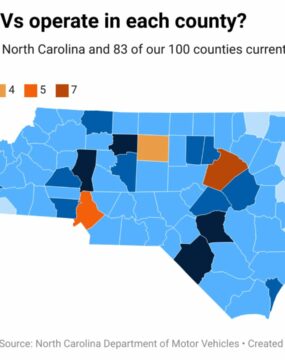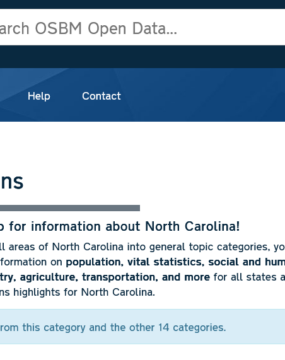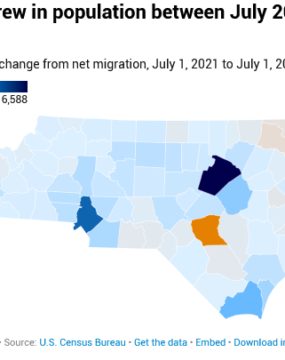NC in Focus
Keep up with our latest demographic insights

After this piece was published, the DMV reached out to Carolina Demography to note that they have implemented several efforts to increase availability of appointments. These include providing walk-in appointments after noon, opening more offices at 7am, and having Saturday office hours for peak season. They also note that every driver license office in the state takes only walk-ins every afternoon. Starting with the 2023 election, voters in North Carolina will be asked to show…

Are you curious how North Carolina ranks among the states for statistical categories like population, education, government, employment, agriculture, transportation, and more? The newly-updated 2023 How NC Ranks data tool from the NC State Data Center (NC SDC) and NC Office of State Budget and Management (NC OSBM) provides data visualizations highlighting selected data points for the US and North Carolina Notably, the tool also provides historical data, which allows analysis and comparisons over time.…

The number of babies born each year in North Carolina, as well as the United States, has been dropping. We published a piece on the topic two years ago when provisional numbers were first released about birthrates during the 2020 pandemic. Since then, the final data has been released. (If you read both this piece and the piece we wrote earlier, you’ll notice that percentages are slightly different – that piece was based on…

The 2022 Population Estimates show that the population of North Carolina grew by 1.3% between July 1st 2021 and July 1st 2022. Among North Carolina’s 100 counties, 74 experienced population growth. The majority of counties grew from people moving in (migration) rather than from having more births than deaths, which is what demographers call natural increase. 74 counties grew between July 2021 and July 2022 North Carolina overall grew by an estimated 1.3% between July…

The U.S. Census Bureau released their 2022 population estimates for municipalities earlier this month. Here’s what the new data tell us about how North Carolina’s cities and towns have changed in the past year. Greensboro passes 300K residents On July 1st 2022, Greensboro’s estimated population was 301,115, up from an estimated 299,225 on July 1st 2021. Wake Forest also passed a major milestone, passing 50,000 residents as of 2022 (as predicted in our blog post…

Dr. Michael Cline is the state demographer for North Carolina at the Office of State Budget and Management and has given us permission to re-post his content here. On May 25, 2023, the US Census Bureau published the Demographic Profile and Demographic and Housing Characteristic (DHC) datasets for the 2020 Census. These datasets provide a more expansive picture of the population counted in the 2020 Census than the 2020 Census data published to date. From…

Dr. Michael Cline is the state demographer for North Carolina at the Office of State Budget and Management and has given us permission to re-post his content here. “We are a safe space where young people and families can be accepted and celebrated for who they are. It’s a safe space to be bilingual, bicultural, and to be yourself.” That is ISLA Executive Director Lwiza Escobar Garcia describing the role her organization plays in the…

From WoW Supermarket in Monroe, to Tienda Mi Pueblo in Durham; from Dirtbag Ales in Hope Mills to Tienda Los Nenes in Asheville; from Pura Vida Worldy Art in Charlotte to Diamante Arts & Cultural Center in Cary. The evidence of Hispanic population’s growth and cultural influence can be found across North Carolina. The Hispanic population in the state hasn’t just grown in the last three decades. Where the Hispanic population lives in North Carolina…

Dr. Michael Cline is the state demographer for North Carolina at the Office of State Budget and Management and has given us permission to re-post his content here. In 1989 a young couple moved to Greenville from Puerto Rico. Like many other young families who relocated to North Carolina, they were pursuing opportunity. The husband was embarking on his career (engineering), as his wife stayed home with their young daughter. Their daughter was soon joined…

Dr. Michael Cline is the state demographer for North Carolina at the Office of State Budget and Management and has given us permission to re-post his content here. In 2012 our office began preparing population estimates and projections of North Carolina’s Hispanic population because the demographic had grown exponentially since 1990 to become a significant part of the overall North Carolina population. These data included annual estimates and projections for Hispanic and Non-Hispanic population groups…
Your support is critical to our mission of measuring, understanding, and predicting population change and its impact. Donate to Carolina Demography today.